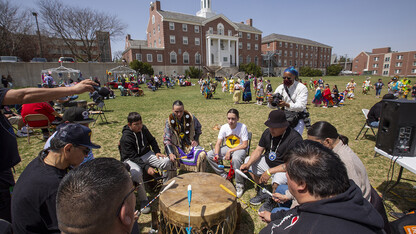· 5 min read
Nebraska in the National News: October 2016

The Trump-Clinton brawl dominated October’s national news coverage – and gave several University of Nebraska-Lincoln scholars the opportunity to offer their perspectives on 2016 presidential politics. Of more than 40 national news items featuring Nebraska faculty, staff or students, at least six dealt with the election.
Jennine Capó Crucet, English, described the second presidential debate in an Oct. 10 New York Times article. She compared GOP candidate Donald Trump to “a student who didn’t do the reading.” Max Perry Mueller, classics and religion, discussed Mike Pence’s religious beliefs in an Oct. 10 piece on Religion and Politics website and Mormons’ role in the “Dump Trump” movement in an Oct. 8 article for Slate.
Sarah Gervais, psychology, commented on Trump’s “locker room banter” in a widely distributed Oct. 8 Yahoo News! item and Susan Swearer, educational psychology, commented on Democratic candidate Hillary Clinton’s anti-bullying proposal in an Oct. 27 Washington Post report.
Frank Gonzalez, a political science doctoral candidate, together with a Wisconsin colleague, unveiled a theory on Politico Oct. 18 that Trump’s unorthodox candidacy could benefit down-ballot GOP candidates.
The presidential race didn’t completely dominate Nebraska’s national coverage, however. Cannibalistic spiders, business education and rural lawyers were among other topics that generated Nebraska-related stories. Some examples:
Eric Berger, law, discussed the state’s repeated failures to obtain lethal injection drugs in an Oct. 6 article by The Associated Press that was carried by news outlets nationwide. The difficulty in getting the drugs demonstrates that the system is broken, he said.
The Washington Post was among several national outlets that reported the death of David Bunnell, the founder of several major technology magazines and a University of Nebraska alumnus who was once president of the campus chapter of the Students for a Democratic Society.
Forbes.com published an Oct. 31 article by Thomas Clemente, agronomy and horticulture, explaining his research effort to create a better soybean. Clemente said soybeans can provide an alternative source of protein and oil for aquaculture, helping to meet growing world consumption of fish. The article was produced through GMO Answers, an initiative to make information about genetically modified organisms easier to understand. The initiative is funded through the Council for Biotechnology Information, which includes BASF, Bayer, Dow AgroSciences, DuPont, Monsanto and Syngenta.
Reuters reported Oct. 14 on a new study by Dipti Dev, child, youth & family studies, that explored day care’s feeding practicing and how they might influence children’s lifelong eating habits.
Richard Ferguson, agronomy, talked about ProjectSENSE, a high-tech fertilization and irrigation project for an Oct. 19 report on agricultural efforts to reduce fertilizer runoff. The story, which originated with Harvest Public Media, was aired nationally on the PBS NewsHour.
Smithsonian interviewed Raymond Hames, anthropology, for his perspective on a California study that examined whether the human propensity for violence and war is inherent to the species or whether it is an outgrowth of organized society. The report appeared Oct. 19.
Eileen Hebets, biological sciences, explained why we notice more spiders in the the fall for an Oct. 14 article in the Akron Beacon-Journal.
The Economist, United Press International and the Gonzaga Bulletin were among outlets carrying reports on a new study by Hebets and Steven Schwartz, biological sciences, that found female dark fishing spiders don’t actually kill males after mating – the males die naturally. The female, however, rolls her dead mate into a ball and eats him. Schwartz, now on the faculty at Gonzaga University, found that by eating their mates, the female spiders produce stronger and more numerous offspring. The Economist described it as “the cruelest one-night stand of all.”
BTN LiveBig featured Matthew Jockers, English, and his research using a Tusker, a room-sized cluster computer, to crack the code separating from a bestselling novel from one that languishes on the shelf. Jockers’ book “The Bestseller Code,” co-authored with Jodie Archer was published in late September.
Richard Moberly, interim law dean, was cited in an Oct. 27 article in the American Bar Association Journal about Nebraska’s new program to encourage students from rural areas to pursue careers as lawyers. The Rural Law Opportunities Program, offered in conjunction with two state colleges and the University of Nebraska at Kearney, is an effort to supply more lawyers to rural areas of the state.
Caterpillars may look cute, but they cold-bloodedly kill one another, Julie Peterson, entomology, explained in an Oct. 1 National Geographic article on misunderstood bugs.
Poets and Quants, which covers U.S. business schools, posted a lengthy question-and-answer discussion with Donde Plowman, dean of Nebraska’s College of Business Administration, on Oct. 4.
The Washington Post interviewed Mario Scalora, psychology, for his take on a new study that found pop-culture celebrities, not governmental officials, are increasingly the targets of violent attack, possibly fueled by the pseudo intimacy of social media. The story citing Scalora, who is director of the Nebraska Public Policy Center, appeared Oct. 12.
“A Warrior of the People,” the third book by Joseph Starita, journalism, was featured by Indian Country Today Media Network on Oct. 5. The article described Starita’s book, which tells the story of physician Susan LaFlesche, as “a masterful depiction.” It included a question-and-answer interview of Starita.
Faculty, administration, student and staff appearances in the national media are logged here. If you have additions to this list or suggestions for national news stories, contact Leslie Reed, the university’s national news editor, at lreed5@unl.edu or 402-472-2059.







